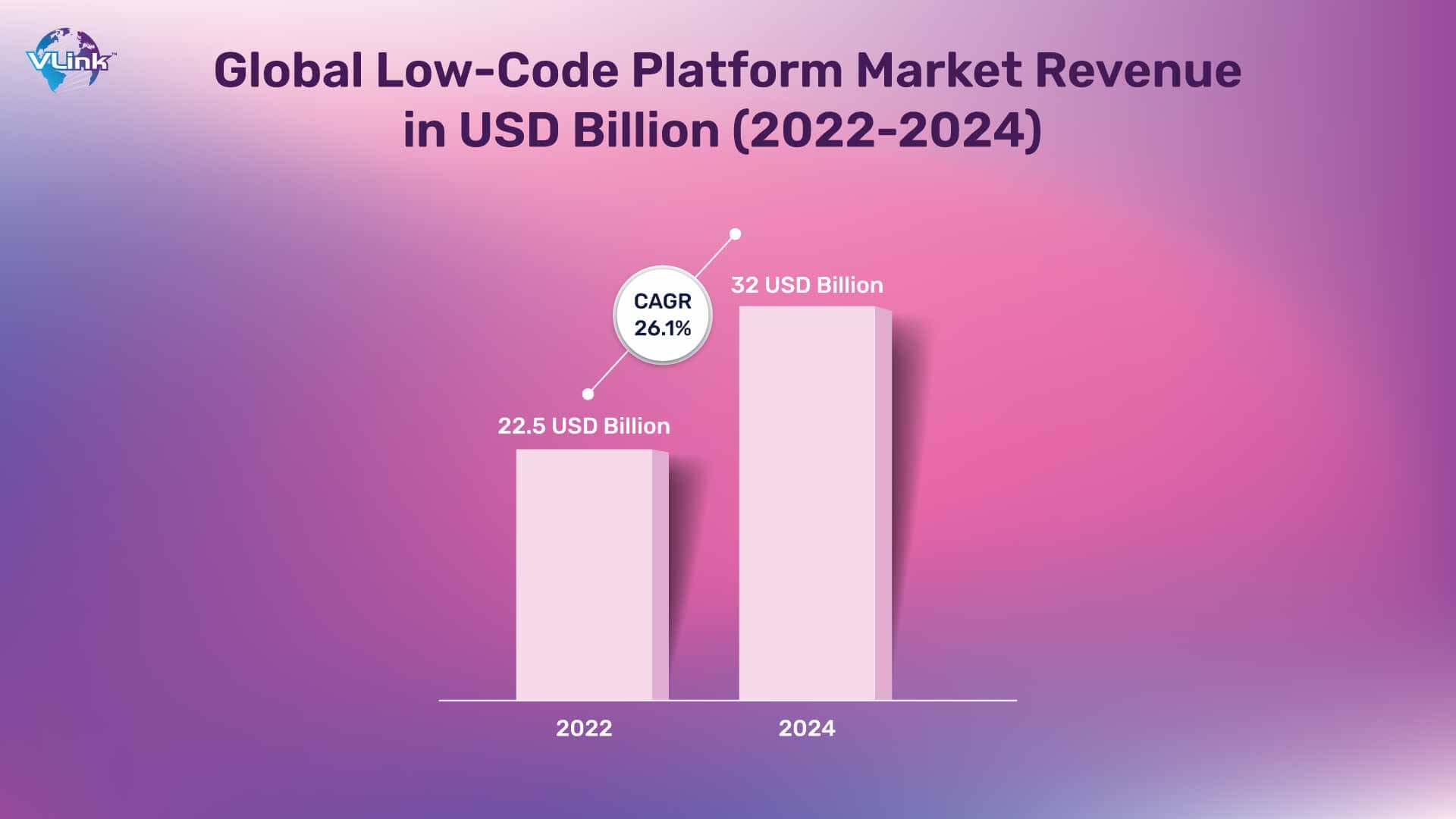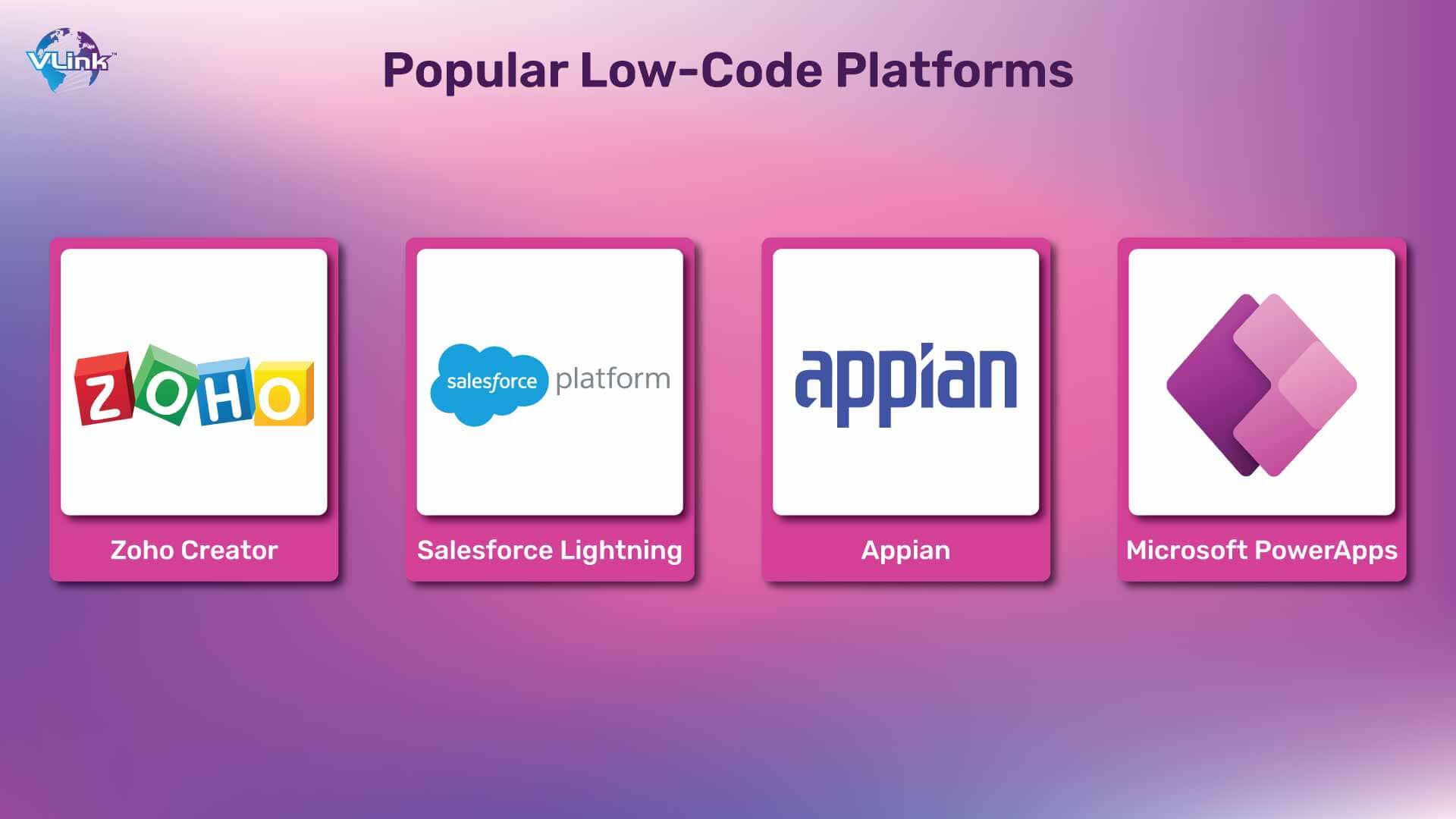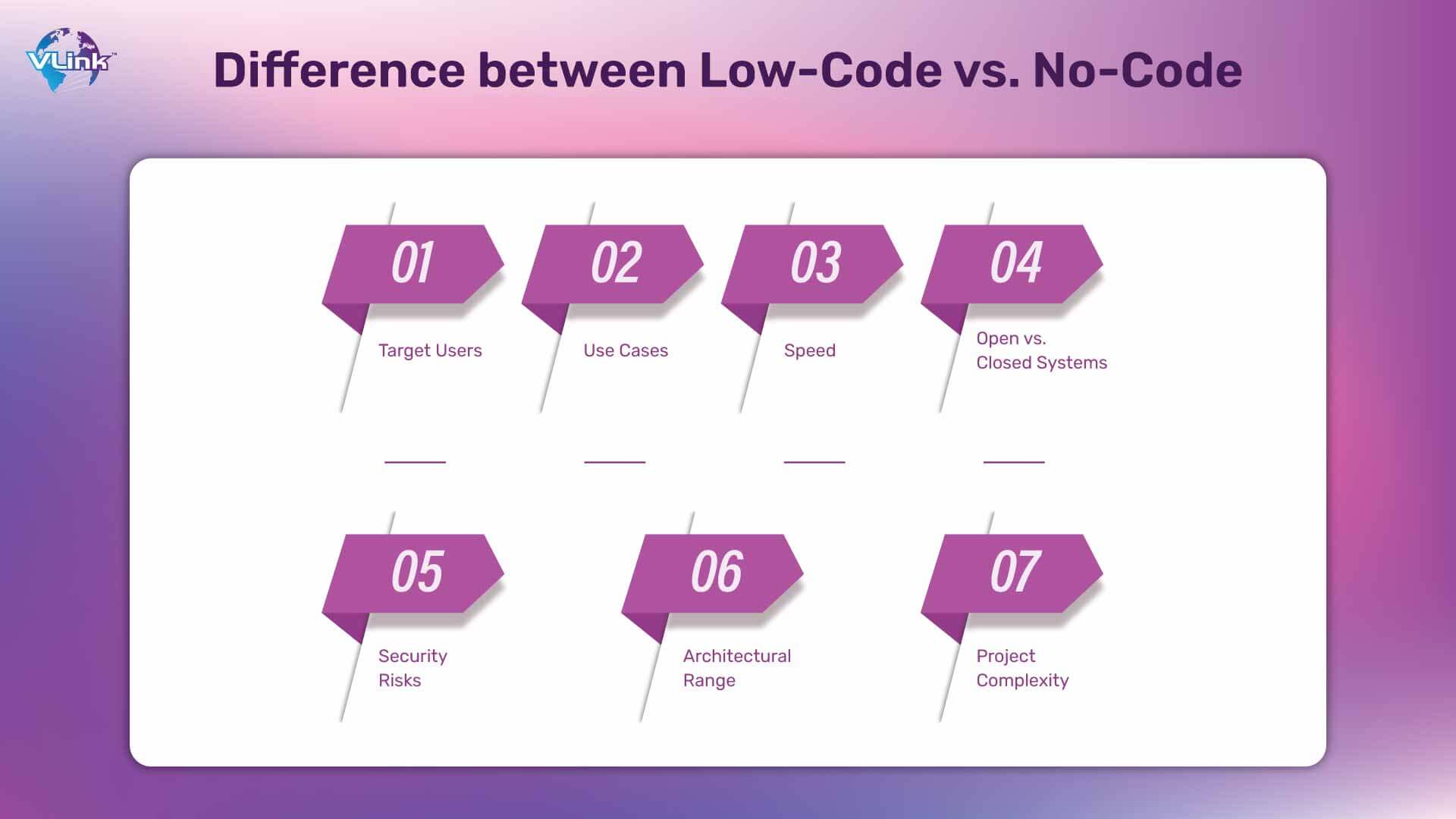Advancing technology and growing competition are at their peak.
In today's dynamic business era, success requires exceptional adaptability, flexibility, and agility. But, achieving these qualities using traditional development methods takes a lot of work.
More companies are now turning to low-code and no-code platforms for faster and more convenient app development solutions. The global low-code platform market revenue was around 22.5 USD billion in 2022 and is expected to reach approx.—32 USD billion by 2024.

Despite this popularity, deciding between low-code vs. no-code development platforms is challenging. While the pros and cons are similar, what suits you best depends on your business and application needs.
In this blog, we will explore the differences between low-code and no-code development for your business,
Low-Code vs. No-Code: What's the Key Difference?
Factors | Low-Code | No-Code |
Users | Professional Developers | Business Users, Developers |
Objectives | Accelerated development, reduced costs and improved agility | Enable business users to create and deploy apps without coding |
Coding Expertise | Some coding expertise required | No coding expertise required |
Project Types | Internal apps, complex apps | Simple apps, workflow, automations |
Platform Extensibility | Can be extended with custom code and plugins | Limited extensibility options |
Complexity and Customization | High complexities and customization capabilities | Limited complexities and customization capabilities |
Scalability | Highly scalable | Have limitation |
Development Speed | Faster than traditional development | Fastest Development Speed |
Skill Level Needs | Higher | Lower |
Vendor Lock-In | Fewer risks of vendor lock-in | Higher risks of vendor lock-in |
Control & Flexibility | More | Less |
Integration with External Systems | Good | Limited |
Security & Compliances | Strong | Limited |
Maintenance & Upgrades | Relatively easy | Difficult |
Learning Curve | Moderate | Low |
Custom User Interface | Higher option | Limited options |
Cost | Can be more expensive | Can be lower expensive |
Support for Complex Logic | Good support | Low support |
Understanding Low-Code and No-Code Development?
What is Low-Code Development?
Low-code development is a software development approach that allows developers to build a low code platform for your business using a few elements:
- Drag-and-drop editor
- Minimal coding
- Customizable code templates
- User-friendly APIs
Low-code programming is the right option to minimize repetitive work and streamline custom app development.
Examples of Popular Low-Code Platforms

- Zoho Creator
- Salesforce Lightning
- Appian
- Microsoft PowerApps
Pros & Cons of Low-Code Development
Pros | Cons |
Great Customization | Security Risks |
Faster Development | Limited Flexibility |
Reduced Costs |
|
Streamlined Process |
|
What is No-Code Development?
No-code app development emphasizes creating apps without traditional coding or programming languages. It empowers non-technical users such as business analysts, marketers, entrepreneurs and citizen developers to build high-quality products or software without coding requirements.
With no-code development platforms, you can expect the following features:
- Codeless drag-and-drop functions
- User-friendly visual tools
- Pre-built templates
Examples of Popular No-Code Platforms
- Appy Pie
- Airtable
- Podio
- Bubble
Pros & Cons of No-Code Development
Pros | Cons |
Fast & Simple | Fewer Customization Options |
Cost-Effective | Less Administrative Control |
Easy Maintenance |
|
Why Should You Go for No-Code/Low-Code Development?
Here are the adoption & usages of no-code and low-code development according to Gartner:
- Worldwide low-code and no-code market size is predicted to reach US$26.9 billion by 2026.
- It’s predicted that 65% of software are developed using low-code/no-code technologies
- By 2024, 65% of all applications are expected to be built using low-code/no-code technologies.
- A significant 41% of organizations have citizen development initiatives in place.
- An impressive 89% of non-users express willingness to adopt no-code tools in the future.
- Over 1024% of users had yet to gain experience with no-code/low-code before utilizing them, with 40% having primarily business backgrounds.
- Despite their widespread use, 37% of enterprises utilizing low-code/no-code platforms have yet to build and deliver any of their highest-value applications with them.
What is the Difference between Low-Code vs. No-Code?

#1 - Target Users
Business users, citizen developers, or individuals with little to no coding experience are target users of no-code development. Users who want to create simple applications or automate business processes quickly.
Low-code platforms target professional developers, IT departments, and more technically proficient users who need more coding skills. But they want to accelerate the enterprise software development process and reduce manual coding efforts.
#2 - Use Cases
Low-code platforms excel in complex enterprise application development, legacy system integration, workflow automation, CRM systems, and mobile app development. They offer pre-built components and visual interfaces, suiting developers with moderate technical skills.
No-code platforms are ideal for website development, CMS solutions, e-commerce platforms, internal tool creation, and rapid prototype design. They empower non-technical users with intuitive drag-and-drop interfaces and customizable templates.
Both approaches enable rapid development and automation, but the choice depends on project complexity and user expertise. Low-code suits developers seeking customization, while no-code is perfect for quick, intuitive solutions tailored for non-technical users.
#3 - Speed
Low-code platforms accelerate development by providing pre-built components and visual interfaces, reducing coding time and complexity. Developers with moderate technical skills can quickly build applications by assembling these components and workflows.
No-code platforms offer even more significant speed by eliminating the need for coding. With intuitive drag-and-drop interfaces and ready-made templates, users can create applications and automate processes rapidly without any programming knowledge.
Low-code and no-code approaches prioritize speed, but no-code platforms typically offer the fastest route to application development. It makes them ideal for quickly deploying solutions and iterating based on user feedback.
#4 - Open vs. Closed Systems
Low-code platforms often operate within closed systems, providing a framework with predefined components and integrations. While they offer flexibility within their ecosystem, customization beyond these boundaries may be limited.
No-code platforms are more open, allowing users to integrate with a broader range of external services and APIs. This openness enables greater flexibility and customization, empowering users to create tailored solutions that meet specific business needs.
While both approaches have advantages, the choice between open and closed systems depends on factors such as the level of customization required and integration needs.
#5 - Security Risks
Low-code platforms, while efficient, can introduce security risks due to the reliance on pre-built components and integrations. Vulnerabilities in these components or misconfigurations could compromise the entire system. Additionally, the rapid pace of development may lead to oversight of security best practices.
No-code platforms may pose top cybersecurity threats, particularly if users need to understand security principles. Users might inadvertently expose sensitive data or create vulnerabilities by misconfiguring permissions or integrations.
Low-code and no-code approaches require vigilant attention to security, including regular audits, adherence to best practices, and thorough different types of software testing services. These measures help identify and mitigate potential risks throughout the development process.
#6 - Architectural Range
Low-code platforms offer a more comprehensive architectural range, allowing developers to build complex applications with custom logic and integrations. They provide flexibility for creating scalable and customizable solutions tailored to specific business needs.
No-code platforms, while powerful, often have a more limited architectural range, focusing on more straightforward applications and workflows. They excel at automating repetitive tasks and building straightforward applications without coding.
Both approaches have their strengths depending on the project requirements and the level of customization needed. Low-code is suitable for complex applications, while no-code is ideal for rapidly developing simpler solutions.
#7 - Complexity of Projects
Low-code platforms are well-suited for handling more complex projects, offering extensive customization options, integrations, and flexibility in development. They cater to developers with varying levels of expertise and enable the creation of sophisticated applications with custom logic.
In contrast, no-code platforms are typically better suited for simpler projects requiring less customization and straightforward workflows. They empower users without coding experience to quickly build applications and automate processes but may need to be improved in handling more complex requirements or integrations.
Low-Code vs. No-Code: When to Use?
Use Low-Code Development When:
- your project requires some custom logic or integration with complex systems but doesn't need extensive coding,
- you need more flexibility and customization options,
- applications need to integrate with multiple systems or data sources.
Use No-Code Development When:
- you want to build simple applications or prototypes without custom coding or complex logic,
- you have limited access to skilled developers,
- you need to quickly prototype and iterate on ideas without getting bogged down in coding details.
What are the Similarities between No-Code Vs. Low-Code Development?
No-code and low-code development share several similarities:
- Visual Development: Both use visual interfaces, drag-and-drop components, and pre-built templates to simplify mobile app development solutions.
- Rapid Prototyping: Both enable fast prototyping and iteration, allowing users to create and test applications quickly without extensive coding.
- Reduced Dependence on Traditional Coding: Both empower non-technical users to create functional applications without deep programming knowledge, accelerating development timelines.
- Focus on Business Needs: Both prioritize meeting business requirements by allowing users to focus on the functionality and logic of the application rather than the underlying technical implementation.
- Empowerment of Citizen Developers: Both aim to empower citizens, enabling individuals from various departments to contribute to application development efforts.
What Should You Pick: Low-Code or No-Code Development? (Final Thought)
Both low-code and no-code development come with their pros and cons. Low-code development is the right option for experienced developers who need a high level of customization and flexibility.
On the other hand, if you want to rapidly build simple applications or automate processes without extensive coding knowledge or resources, no-code platforms would be a better choice.
It's essential to evaluate your project requirements, team expertise, time constraints and long-term scalability before deciding.
Low-code and no-code are robust automation solutions. Both approaches can minimize a lot of work and save resources, but they also come with risks! That's why you'll want to partner with a trustworthy software development company that can help you avoid the pitfalls.
VLink is for your development needs, whether low-code or high-code. No-Code!
VLink is a software development company with experience delivering and integrating no-code and low-code solutions. Our dedicated team of experts ensure these apps harmonize with your existing architecture and interface with your legacy systems. In addition, we prioritize data security, mitigating risks and preventing potential shadow IT concerns, providing comprehensive and reliable solutions.
Here are reasons to choose VLink for low-code or no-code software development:
- Deliver on-demand low-code development consulting for optimum and robust business solutions
- 360-degree analysis of low code implementation for successful adaptation of your business strategy
- Leverage a vision-focused low code development strategy after rooted project analysis
- Have experienced low code and no code developers with niched experience
- Avail full-fledged low code and no code app maintenance support before posting app release
Unlock the full potential of low-code and no-code development for your organization with us. Contact us now!
Frequently Asked Questions
Low-code is the future due to its ability to democratize application development, enabling faster delivery of software solutions by citizen developers and reducing dependency on traditional coding. Its visual, intuitive interfaces streamline development, accelerating digital transformation and empowering organizations to adapt swiftly to evolving market demands.
No-code and low-code serve different purposes. No-code is simpler, empowering non-technical users to build basic applications, while low-code offers more customization and flexibility, suitable for complex projects. The choice depends on the project's requirements and the user's technical proficiency.
The challenges of low-code and no-code development include limited customization, scalability concerns, potential vendor lock-in, security vulnerabilities, and complexity in handling more intricate tasks. Balancing simplicity with flexibility and ensuring robustness remain pivotal hurdles in these approaches.








